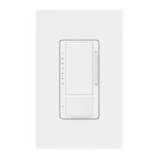
While occupancy sensor controls were originally created for use in commercial buildings, their role in residential buildings is becoming more commonplace. Many lighting companies have introduced automated lighting control product lines specifically for use in residential buildings and homes. These include occupancy sensor switches that have a sleek design that deliver proportional results to commercial counterparts, and cost much less. While these use the same technology as passive infrared occupancy sensors for commercial buildings, they do not need to be as powerful. The capacity of the controller does not need to detect occupancy by such an expansive measure because it is employed in rooms that have much lower ceilings and dramatically less square footage.
In addition to the price tag, the design of these components also benefits as compared to commercial occupancy sensors. The actual module can pack the required technology in a smaller clamshell that easily fits in a traditional wall switch junction box. Manufacturers are also taking the initiative to offer decorative faceplates to match the décor in your home. One company that seems to be doing all of this better than others is Lutron.
In addition to the price tag, the design of these components also benefits as compared to commercial occupancy sensors. The actual module can pack the required technology in a smaller clamshell that easily fits in a traditional wall switch junction box. Manufacturers are also taking the initiative to offer decorative faceplates to match the décor in your home. One company that seems to be doing all of this better than others is Lutron.
The Maestro collection by Lutron is an industry leading line of lighting products for residential use. Available occupancy sensors of the collection include:
Lutron MS-OPS2-WH Maestro 250 Watt Single Pole
Lutron MS-OP600M-WH Maestro 600 Watt (with Eco-Dim)
Lutron MS-VP600GHW-WH Maestro Vacancy Sensor (with Eco-Dim)
The difference between the MS-OPS2 and the MS-OP600M is slight. However, for a few extra bucks you can get the extra
feature of dimmable controls with the MS-OP600M. Lutron is a huge advocate of dimming lights to save energy, and the math doesn’t lie when portraying this point. Upgrading to the occupancy sensors with Eco-Dim technology can really be
worth it, and in fact increase your return on investment.
The difference between the MS-OP600M and MS-VP600GHW is the fairly important. While each automatic light controller delivers the Eco-Dim function, the first is an occupancy sensor while the second is a vacancy sensor. Understanding the difference between an occupancy sensor and a vacancy sensor is important. Each has its own preferable applications where it is more suitable than the other. For example, vacancy sensors are popular in the bedroom where you might not want the lights to turn on when you enter if someone else is sleeping. However, your children might struggle to remember to turn the lights off when the leave, making a vacancy sensor a more suitable product. In contrast, laundry rooms and storage areas are great rooms for occupancy sensors, where flicking the light switch is a struggle when entering with your hands full.
Lutron MS-OPS2-WH Maestro 250 Watt Single Pole
Lutron MS-OP600M-WH Maestro 600 Watt (with Eco-Dim)
Lutron MS-VP600GHW-WH Maestro Vacancy Sensor (with Eco-Dim)
The difference between the MS-OPS2 and the MS-OP600M is slight. However, for a few extra bucks you can get the extra
feature of dimmable controls with the MS-OP600M. Lutron is a huge advocate of dimming lights to save energy, and the math doesn’t lie when portraying this point. Upgrading to the occupancy sensors with Eco-Dim technology can really be
worth it, and in fact increase your return on investment.
The difference between the MS-OP600M and MS-VP600GHW is the fairly important. While each automatic light controller delivers the Eco-Dim function, the first is an occupancy sensor while the second is a vacancy sensor. Understanding the difference between an occupancy sensor and a vacancy sensor is important. Each has its own preferable applications where it is more suitable than the other. For example, vacancy sensors are popular in the bedroom where you might not want the lights to turn on when you enter if someone else is sleeping. However, your children might struggle to remember to turn the lights off when the leave, making a vacancy sensor a more suitable product. In contrast, laundry rooms and storage areas are great rooms for occupancy sensors, where flicking the light switch is a struggle when entering with your hands full.
| | | |
 RSS Feed
RSS Feed